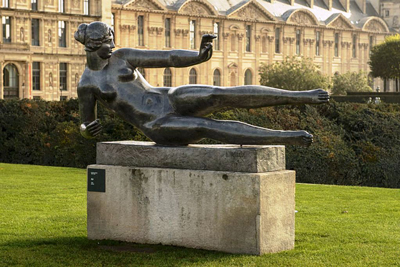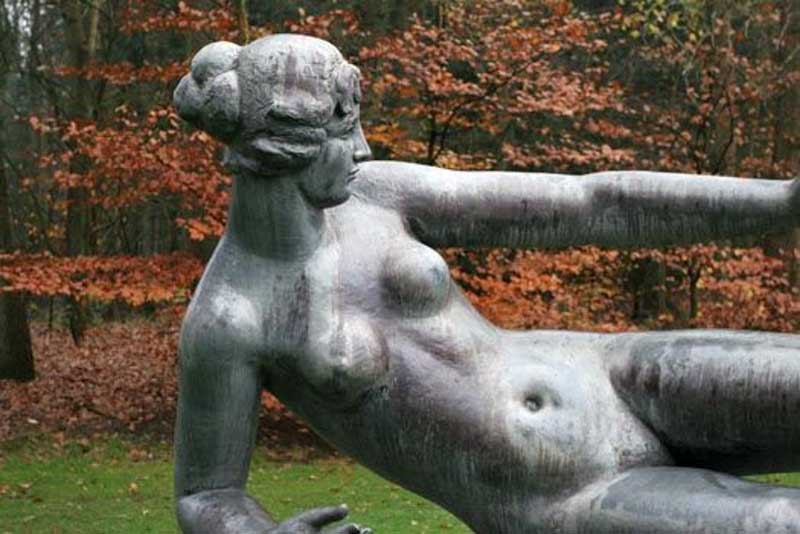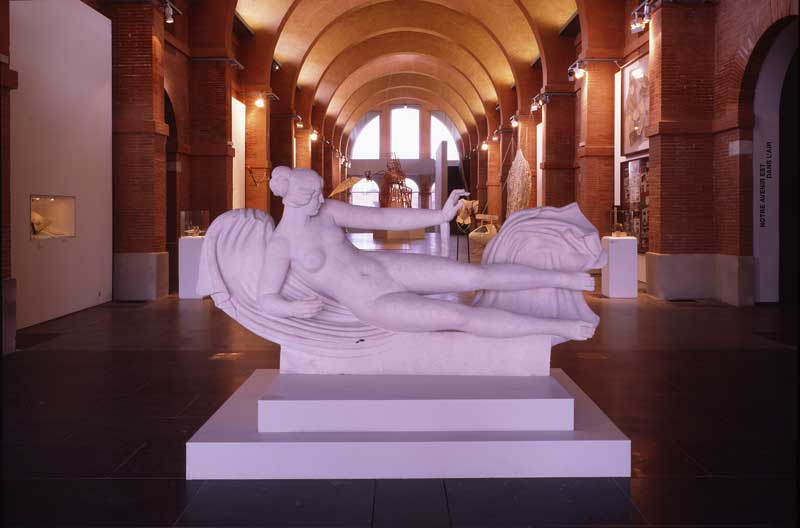
In 1938, the city of Toulouse in southern France commissioned Aristide Maillol to commemorate the crews of the hydroplane Croix du Sud, belonging to the pioneering airmail service l'Aéropostale, which left on 7th December 1936 for the twenty-fourth trans-Atlantic crossing of a newly established mail service between France and South America and disappeared after take-off. Created by the French artist Aristide Joseph Bonaventure Maillol, the monumental nude depicted in L’Air, seems to float in space.
Though it is made of lead, the figure seems to be almost weightless only resting on the right hip. Balanced delicately on her right hip, the figure's extended legs and left arm create a strong horizontal, echoed in the plinth beneath her. Resting on an imaginary center of gravity, she seems to lurch between immobility and movement, suspension and flight. Rather than a portrait of an individual, the face and the figure of the nude seems to be idealized and related to the natural elements like air, spring, river and others. In fact, the artist often used the female form to symbolize aspects of nature like the sea, the seasons and even a subject as elusive as air.

The exquisite features of the nude with her almost subdued face presents the impression as if the young woman is falling from the air, which is a reminder of the motive behind the memorial sculpture, dedicated to all those that lost their lives for the Aeropostale service from its pioneering days.
L’Air in Toulouse is one of a series of approximately six other productions cast from the original that can be found in museums in different countries, which are Kroller-Muller Museum in the Netherlands, Yale University Art Gallery in USA, Jardin des Tuileries in Paris, J Paul Getty Museum in California in USA, Norton Simon Museum also in California and Kimbell Art Museum in Texas in USA.
Initially, Maillol took the help of one of his earlier compositions, for the style of portraying a nude female in L’Air. Thereafter, he made a plaster version, based upon Dina Vierny, who was the model and muse of Aristide Maillol for the last ten years of his life.

While the artist was working on the sculpture, the reputed art historian John Rewald visited him at his winter studio in Banyuls and according to him, Maillol based his idea upon a small terracotta, that he had made around 1900, displaying a woman reclining on billowing drapery, as if to represent a Greek goddess at court in the clouds or on the sea. It is a fact that since classical antiquity, the image of the healthy nude woman has symbolized beauty, truth and innocence, among other abstract ideas. It is evident that Maillol’s own interest in the general pose first appeared in his paintings of bathers around 1895, derived from the works on this theme by Gauguin and Renoir.

Maillol’s first work in the form of a recumbent female nude evolved from his commission to create a monument to Cézanne, installed in Musée d’Orsay, Paris and his own paintings of bathers were made in dialogue with works by Renoir. According to John Rewald, Maillol developed the pose by cutting up a version of the figure he had already developed for the Cézanne monument and subtly rearranging the parts, the artist created an altogether original work which appears still more beautiful than the initial statue.
Maillol often referred to nature along with Greek mythology to relate to his works of art. The majority of his later works are evolved around the female form in an almost classical style and often nude, plus many like this one were depicted with their hair tied up in a bun.
